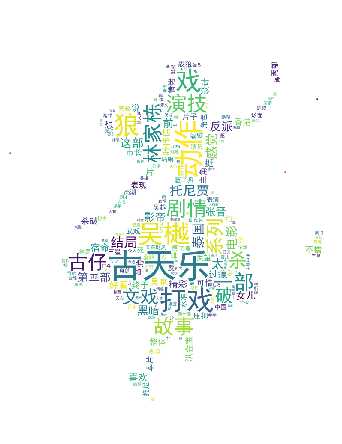标签:off urlopen from ttf pandas 提取数据 parse mat coding
利用python对豆瓣电影评价的爬取,并生成词云
第一步要对网页进行访问,python中使用的是urllib库。代码如下:
from urllib import request
resp = request.urlopen(‘https://movie.douban.com/nowplaying/hangzhou/‘)
html_data = resp.read().decode(‘utf-8‘)
第二步,需要对得到的html代码进行解析,得到里面提取我们需要的数据。
在python中使用BeautifulSoup库进行html代码的解析。
BeautifulSoup使用的格式如下:
BeautifulSoup(html,"html.parser")
第一个参数为需要提取数据的html,第二个参数是指定解析器,然后使用find_all()读取html标签中的内容from bs4 import BeautifulSoup as bs soup = bs(html_data, ‘html.parser‘) nowplaying_movie = soup.find_all(‘div‘, id=‘nowplaying‘) nowplaying_movie_list = nowplaying_movie[0].find_all(‘li‘, class_=‘list-item‘)
在上图中可以看到data-subject属性里面放了电影的id号码,而在img标签的alt属性里面放了电影的名字,因此我们就通过这两个属性来得到电影的id和名称。(注:打开电影短评的网页时需要用到电影的id,所以需要对它进行解析),编写代码如下:
nowplaying_list = []
for item in nowplaying_movie_list:
nowplaying_dict = {}
nowplaying_dict[‘id‘] = item[‘data-subject‘]
for tag_img_item in item.find_all(‘img‘):
nowplaying_dict[‘name‘] = tag_img_item[‘alt‘]
nowplaying_list.append(nowplaying_dict)
为了方便进行数据进行清洗,我们将列表中的数据放在一个字符串数组中,代码如下:
comments = ‘‘
for k in range(len(eachCommentList)):
comments = comments + (str(eachCommentList[k])).strip()
代码如下:
import matplotlib.pyplot as plt
%matplotlib inline
import matplotlib
matplotlib.rcParams[‘figure.figsize‘] = (10.0, 5.0)
from wordcloud import WordCloud#词云包
wordcloud=WordCloud(font_path="simhei.ttf",background_color="white",max_font_size=80) #指定字体类型、字体大小和字体颜色
word_frequence = {x[0]:x[1] for x in words_stat.head(1000).values}
word_frequence_list = []
for key in word_frequence:
temp = (key,word_frequence[key])
word_frequence_list.append(temp)
wordcloud=wordcloud.fit_words(word_frequence_list)
plt.imshow(wordcloud)
付源码:完整代码
# -*- coding: utf-8 -*-
import warnings
warnings.filterwarnings("ignore")
import jieba # 分词包
import numpy # numpy计算包
import codecs # codecs提供的open方法来指定打开的文件的语言编码,它会在读取的时候自动转换为内部unicode
import re
import pandas as pd
import matplotlib.pyplot as plt
from PIL import Image
from urllib import request
from bs4 import BeautifulSoup as bs
from wordcloud import WordCloud,ImageColorGenerator # 词云包
import matplotlib
matplotlib.rcParams[‘figure.figsize‘] = (10.0, 5.0)
# 分析网页函数
def getNowPlayingMovie_list():
resp = request.urlopen(‘https://movie.douban.com/nowplaying/hangzhou/‘)
html_data = resp.read().decode(‘utf-8‘)
soup = bs(html_data, ‘html.parser‘)
nowplaying_movie = soup.find_all(‘div‘, id=‘nowplaying‘)
nowplaying_movie_list = nowplaying_movie[0].find_all(‘li‘, class_=‘list-item‘)
nowplaying_list = []
for item in nowplaying_movie_list:
nowplaying_dict = {}
nowplaying_dict[‘id‘] = item[‘data-subject‘]
for tag_img_item in item.find_all(‘img‘):
nowplaying_dict[‘name‘] = tag_img_item[‘alt‘]
nowplaying_list.append(nowplaying_dict)
return nowplaying_list
# 爬取评论函数
def getCommentsById(movieId, pageNum):
eachCommentList = []
if pageNum > 0:
start = (pageNum - 1) * 20
else:
return False
requrl = ‘https://movie.douban.com/subject/‘ + movieId + ‘/comments‘ + ‘?‘ + ‘start=‘ + str(start) + ‘&limit=20‘
print(requrl)
resp = request.urlopen(requrl)
html_data = resp.read().decode(‘utf-8‘)
soup = bs(html_data, ‘html.parser‘)
comment_div_lits = soup.find_all(‘div‘, class_=‘comment‘)
for item in comment_div_lits:
if item.find_all(‘p‘)[0].string is not None:
eachCommentList.append(item.find_all(‘p‘)[0].string)
return eachCommentList
def main():
# 循环获取第一个电影的前10页评论
commentList = []
NowPlayingMovie_list = getNowPlayingMovie_list()
for i in range(10):
num = i + 1
commentList_temp = getCommentsById(NowPlayingMovie_list[0][‘id‘], num)
commentList.append(commentList_temp)
# 将列表中的数据转换为字符串
comments = ‘‘
for k in range(len(commentList)):
comments = comments + (str(commentList[k])).strip()
# 使用正则表达式去除标点符号
pattern = re.compile(r‘[\u4e00-\u9fa5]+‘)
filterdata = re.findall(pattern, comments)
cleaned_comments = ‘‘.join(filterdata)
# 使用结巴分词进行中文分词
segment = jieba.lcut(cleaned_comments)
words_df = pd.DataFrame({‘segment‘: segment})
# 去掉停用词
stopwords = pd.read_csv("stopwords.txt", index_col=False, quoting=3, sep="\t", names=[‘stopword‘],
encoding=‘utf-8‘) # quoting=3全不引用
words_df = words_df[~words_df.segment.isin(stopwords.stopword)]
# 统计词频
words_stat = words_df.groupby(by=[‘segment‘])[‘segment‘].agg({"计数": numpy.size})
words_stat = words_stat.reset_index().sort_values(by=["计数"], ascending=False)
# print(words_stat.head())
bg_pic = numpy.array(Image.open("alice_mask.png"))
# 用词云进行显示
wordcloud = WordCloud(
font_path="simhei.ttf",
background_color="white",
max_font_size=80,
width = 2000,
height = 1800,
mask = bg_pic,
mode = "RGBA"
)
word_frequence = {x[0]: x[1] for x in words_stat.head(1000).values}
# print(word_frequence)
"""
word_frequence_list = []
for key in word_frequence:
temp = (key, word_frequence[key])
word_frequence_list.append(temp)
#print(word_frequence_list)
"""
wordcloud = wordcloud.fit_words(word_frequence)
image_colors = ImageColorGenerator(bg_pic) # 根据图片生成词云颜色
plt.imshow(wordcloud) #显示词云图片
plt.axis("off")
plt.show()
wordcloud.to_file(‘show_Chinese.png‘) # 把词云保存下来
main()

标签:off urlopen from ttf pandas 提取数据 parse mat coding
原文地址:https://www.cnblogs.com/qq1141100952com/p/8906070.html